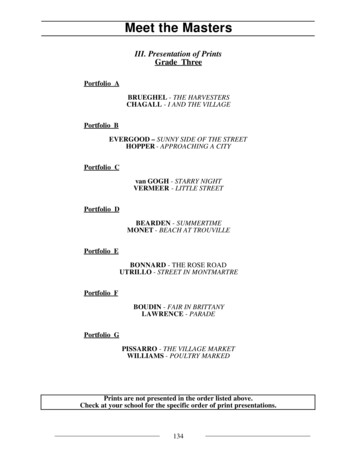
Transcription
Meet the MastersIII. Presentation of PrintsGrade ThreePortfolio ABRUEGHEL - THE HARVESTERSCHAGALL - I AND THE VILLAGEPortfolio BEVERGOOD – SUNNY SIDE OF THE STREETHOPPER - APPROACHING A CITYPortfolio Cvan GOGH - STARRY NIGHTVERMEER - LITTLE STREETPortfolio DBEARDEN - SUMMERTIMEMONET - BEACH AT TROUVILLEPortfolio EBONNARD - THE ROSE ROADUTRILLO - STREET IN MONTMARTREPortfolio FBOUDIN - FAIR IN BRITTANYLAWRENCE - PARADEPortfolio GPISSARRO - THE VILLAGE MARKETWILLIAMS - POULTRY MARKEDPrints are not presented in the order listed above.Check at your school for the specific order of print presentations.134
Meet the Masters550BRUEGHEL, PIETERThe HarvestersMetropolitan Museum of ArtNew York1214 CHAGALL, MARCI and the VillageMuseum of Modern ArtNew York135
Meet the MastersGrade ThreeARTIST:BRUEGHEL, PIETER (Broo-gl, Pee-ter) (1525-1569)PRINT:HARVESTERSMETROPOLITAN MUSEUM OF ARTNEW YORK CITYNorthern RenaissanceDate: 1565Size: 46 1/8” x 63”Medium: Oil on WoodARTIST - Pieter Brueghel, The Elder, was a Flemish artist of the sixteenth century. He studied inAntwerp and was a registered member of the Antwerp Guild. In 1563, he moved to Brussels,married, and began raising a family. He had a successful life as a painter and was a member of adistinguished group of humanists. His favorite subjects were peasants and country scenes. Hispaintings are often called 'genre' (daily life) paintings. He painted peasants merrymaking, feasting,and working and because of this people sometimes think of him as one of the Flemish peasants.He was even nicknamed “Peasant Brueghel.” He believed that peasant life was rough and saw it inrelationship to the background of nature. Brueghel’s peasants are stolid, hearty members of thecommunity. He portrayed them in broad, flat areas of color, with structural perspective andgrandeur of composition. His two sons, (Pieter, The Younger, and Jan, called Velvet), both becamepainters. The name Brueghel is also spelled Bruegel depending on the reference book used,particularly for Pieter, The Elder.PRINT - The Harvesters, was originally named August. It depicts peasants in their daily activitiesin the fields. Like most of Brueghel's work, this painting tells a story. The work, customs anddress of the workers are clearly seen. The figures are solid and rounded. Most of their activity isin the foreground, or front of the picture. Brueghel achieves depth by painting an area of hills andtrees in the middle ground. Behind it the fading background is almost hidden in a mist ofatmosphere. The large tree in the foreground serves to unite the whole picture. As with most of hisworks, humans and nature are bound together in the composition.PORTFOLIO APAIRED WITH:CHAGALLI AND THE VILLAGE136
Meet the MastersGrade ThreeARTIST:CHAGALL, MARC (Shah-gohl, Mark) (1887-1985)PRINT:I AND THE VILLAGEMUSEUM OF MODERN ARTNEW YORK CITYSchool of ParisDate: 1911Size: 63 5/8” x 59 5/8”Medium: Oil on CanvasARTIST - Marc Chagall was born and spent his childhood in a small humble village in Russia.He was one of nine children in a poor family. His parents recognized his art talent and made surehe had art lessons. He studied in St. Petersburg, Russia before he moved to Paris in 1910. He wassoon a member of a group of artists living in Montmartre, France.Chagall has a personal style using a bright range of colors and portraying his childhood memories.They do not look realistic because they are in a free-floating composition. There is a fantasyquality to his painting. His paintings show fanciful scenes and simple folk-life scenes.PRINT - In I and the Village, reality is mixed with happy remembrances and the result is adelightfully personal style. The surface is based somewhat on Cubism, because it has fracturedplanes. The images and presentation are solely Chagall's. The cow dreams happily of a milkmaid,lovers are on their way to the field, (one right-side up, and the other upside down). The villagestreet has some upside down houses, and a green-faced man holds a fantastic plant as he views theentire scene. Chagall himself says of his paintings, "I do not understand them at all. They are notliterature. They are only pictorial arrangements of images that obsess me."PORTFOLIO APAIRED WITH:BRUEGHELHARVESTERS137
Meet the MastersGrade ThreeBRUEGHEL - HARVESTERSCHAGALL - I AND THE VILLAGEQUESTIONS FOR DISCUSSION1. What is alike in both pictures?2. What is different in both pictures?3. Which picture contains larger shapes?What kind are they?4. Can you find any objects that overlap? (One object placed on top of the other.)5. Can you tell me a story about the dream in I and the Village ?6. Can you tell me a story about what the people are doing in The Harvesters ?7. Can you show me objects that are far away in each picture?Can you show me objects that are close to you in each picture?RELATED ACTIVITIES1. You know about geometric shapes such as circles, squares, rectangles, triangles and ovals.Natural shapes are shapes found in nature such as the shape of a leaf, flower, bird or fish.Use construction paper to tear and cut geometric and natural shapes in a variety of sizes.Design a composition using these shapes. You may overlap some. Place smaller ones on topof larger ones. Fill your page just like the two artists did. Add details with colored pencils,crayons or marker.2. Pretend you live in a small village. There are animals, small houses and farms.Draw a picture about living there.SKILLS REINFORCED - SUNSHINE STATE STANDARDSVisual Arts:Visual Arts:Mathematics:Language Arts:Uses elements and principles of art.Understand similarities and differences among different genres of art.Makes two-dimensional shapes.Comprehends visual communication.138
Meet the Masters871EVERGOOD, PHILIPSunny Side of the StreetCorcoran GalleryWashington, D.C.1734 HOPPER, EDWARDApproaching a CityPhillips CollectionWashington, D.C.139
Meet the MastersGrade ThreeARTIST:EVERGOOD, PHILLIP (1901-1973)PRINT:SUNNY SIDE OF THE STREETCORCORAN GALLERYWASHINGTON, D.C.20th Century AmericanDate: 1950Size: 50" x 36 1/4"Medium: Egg-oil VarnishEmulsion with Marble Dustand Glass on CanvasARTIST - Philip Evergood was born in New York, but educated primarily at Eton and Cambridgein England. His education included music lessons, and he became a good enough musician to play,in concert, with his teacher. In 1921, he decided to study art and went to London to study withTonks at the Slade School.Recognition of his talent was sporadic and slow in coming. He taught both music and art to make aliving. In 1952, he moved to Southbury, Connecticut.Evergood is noted for his deliberately awkward drawing and spontaneous bold lines.PRINT - In this scene of a New York City street, we can almost hear the noise that never stops. Inthe background, we can see the towers of a bridge that crosses New York's East River. Thebuildings are lined with fire escapes and television aerials that pierce into the sky, forming a designmade of spiky lines. Many people are outside to escape the indoor heat. We see a blind man witha cane; the people sitting on their stoops, or leaning out of windows. We also see children playinghockey in the street. In the distance, almost unnoticed, there are two ambulance attendants placing apatient on a stretcher. The overall feeling of this painting is one of constant activity on the crowdedstreet.PORTFOLIO BPAIRED WITH:HOPPERAPPROACHING A CITY140
Meet the MastersGrade ThreeARTIST:HOPPER, EDWARD (1882-1967)PRINT:APPROACHING A CITYPHILLIPS COLLECTIONWASHINGTON, D.C.20th Century AmericanDate: 1946Size: 27” x 36Medium: Oil on canvasARTIST - Edward Hopper was born in Nyack, New York and initially studied art in New York. In1906, he studied art in Paris but kept to himself, seldom entering art circles. Returning to America,he sold a canvas at the 1913 Armory Show. He abandoned painting for ten years and devoted histime to commercial illustration. When he took up painting again at age 43, he approached it as amature man with a definite viewpoint.Hopper was preoccupied with loneliness. He found it everywhere and painted it. A stillness andvague emptiness are present in his works. A single house or isolated people remind the viewer of asuddenly remembered moment. His 'remembered moments' were gathered traveling about thecountry throughout his life. He ignored nature and focused on man-made objects.PRINT - In Approaching a City, Hopper gives us his interpretation of city life. He paid attentionto the details of the buildings. They are constructed solidly. The same feeling is there for thetunnel and railroad tracks in the foreground of the painting. The obvious absence of people and theactivity of a city give us an eerie feeling of loneliness and desertion. Adding to this is the traintracks leading into the darkness of the tunnel. It could almost be a pre-dawn scene, but the smallpatch of blue sky tells us a different story.PORTFOLIO BPAIRED WITH:EVERGOODSUNNY SIDE OF THE STREET141
Meet the MastersGrade ThreeEVERGOOD – SUNNY SIDE OF THE STREETHOPPER - APPROACHING A CITYQUESTIONS FOR DISCUSSION1. Do the places in these paintings look like places in your neighborhood? Why?2. What shapes are repeated in both pictures?Where are these shapes?3. Can you estimate how many people live here?4. Does your neighborhood have that many people?5. Why do you think people choose to live in a city or in the country?6. Can you find lines in the Sunny Street ?7. What do you think happened to the people in Hopper's picture?8. What colors make Sunny Street look sunny?9. Where does the road take you in each picture?RELATED ACTIVITIES1. Use many shapes to draw a map of your neighborhood. Ask yourself: How many houses arethere? Are there any stores, churches, police stations, fire houses, or other special buildings?2. Is your school in your neighborhood? You may add trees, people, signs, animals, mailboxesand any other details you can remember. Fill your page.SKILLS REINFORCED - SUNSHINE STATE STANDARDSVisual Arts:Mathematics:Language Arts:Social Studies:Creates work of art from personal experience.Uses estimation strategies in real world problemsUnderstands use of maps to gather informationUnderstands why certain areas are more densely populated.142
Meet the Masters1399VAN GOGH, VINCENTStarry NightMetropolitan Museum of ArtNew York534VERMEER, JOHANNESLittle StreetRijksmuseumAmsterdam143
Meet the MastersGrade ThreeARTIST:van GOGH, VINCENT (Go, Vin-sent Van) (1853-1890)PRINT:THE STARRY NIGHTMUSEUM OF MODERN ARTNEW YORK CITYPost -ImpressionismDate: 1889Size: 29" x 36 1/4"Medium: Oil on CanvasARTIST - Vincent van Gogh was Dutch by birth and the son of a Protestant pastor. He believedthat he had a religious calling and for many years did missionary work in the slums and the miningdistricts of Belgium. He was sensitive and gentle by nature. He longed to be of humble service, buthe failed in everything that he tried to do for these poor people. After repeated failures, he wasexhausted and close to despair. Vincent van Gogh turned to art. He had a will to create and share.He was determined to give happiness by creating beauty.Vincent van Gogh's life was full of heartbreak, loneliness and poverty. He sold almost none of hispaintings and depended on his brother Theo completely for his support. Vincent van Gogh wasknown to have violent mood swings, thus making himself very unpopular and even mocked. It wasin one of these violent moods that he cut off his own ear and sent it to an old girlfriend. For severalyears he was put in a mental institution where he continued painting. It wasn't until later in his lifethat it was discovered he suffered from epilepsy, which explained his moodiness. Vincent vanGogh died alone, when he was only 37 years old.PRINT - The Starry Night is one of Vincent van Gogh's finest paintings. He liked to use brightcolors, particularly blue and yellow. He was known for his thick, heavily applied paints. In many ofvan Gogh's paintings you can see the brush strokes in the paint. The strokes create a texture, apattern, or an emotional impact that is so common in his works.In The Starry Night Vincent van Gogh did not paint the sky as a calm dark blue background withsmall twinkling stars. He created a universe filled with whirling and exploding stars, full ofmovement and emotion. The wavy, curved cypress tree in the foreground is often found in vanGogh's paintings. His use of thick paint and brush strokes is seen in the tree as well as the sky.Vincent van Gogh said that he sought to give comfort and consolation in his painting. He onceexplained, "instead of trying to reproduce exactly what I have before my eyes, I use color morearbitrarily so as to express myself forcibly."PORTFOLIO CPAIRED WITH:VERMEERLITTLE STREET144
Meet the MastersGrade ThreeARTIST:VERMEER, JOHANNES (VER-meer, Yo-hahn) (1632-1675)PRINT:LITTLE STREETRIJKSMUSEUMAMSTERDAM, HOLLANDDutch and Flemish MastersDate: circa - 1659-1660Size: 21 3/8” x 17 1/4”Medium: CanvasARTIST - Johannes Vermeer was born in Delft, Holland where his father was an art dealer andinnkeeper. An Italian painter, Caravaggio, who used light and shade in paintings, influenced him.When Vermeer was 21, he was received as a master painter in the guild of St. Luke. Vermeer andhis fellow artists painted men, women and children engaged in household tasks or some littlerecreation. They reflect the values and activities of the simple domestic life style. Vermeer wasmarried at the age of 20 and was the father of 8 children. He died at 43, leaving behind only 39 or40 canvases that are known to be genuine Vermeers. These paintings represent Dutch genre (dailylife) painting at its climax.PRINT - Vermeer's paintings show us a shining world of calmness and order. Common itemsstand out in fresh beauty. Simple human scenes have a quiet charm in the homes of the Holland ofhis day. In Little Street, Vermeer paints such a scene. Here is a typical home scene of womengoing about their daily tasks. As one woman sits in her doorway serving, two others are in the frontappearing to wash the walkway. A fourth woman is seen in the alley attending to anotherhousekeeping task. The scene has a quiet restfulness to it.Vermeer uses perspective to draw us into the picture. The warm, calm colors he used to paint thebuilding and ground add to the tranquil and calm feeling. He has preserved for us a moment intime during the daily life of the Dutch people.PORTFOLIO CPAIRED WITH:van GOGHSTARRY NIGHT145
Meet the MastersGrade Threevan GOGH - STARRY NIGHTVERMEER - LITTLE STREETQUESTIONS FOR DISCUSSION1. What is the same about these two paintings? What is different?2. Can you find objects that are close and some that are far away in each picture?3. Can you show me the movement in the sky in each picture?4. Can you show me textures (rough or smooth) in each picture?5. What time of day does each picture take place?6. Which picture looks warm, which picture looks cool?7. Can you show me objects that are far away in each picture?8. What do you think the women are doing in Little Street?RELATED ACTIVITIES1. Make a list of things that are alike and different about the two pictures.2. Use your list to write an explanation of why you like one better than the other.3. Have you ever been out on a starry night with a big moon? Draw a picture about the skyon a night like this.4. Draw a picture about people who work outside on your street; mowing lawns, hanginglaundry, washing cars, or another activity of your choice.SKILLS REINFORCED - SUNSHINE STATE STANDARDSVisual Arts:Describes, analyzes and makes judgments about a work of art.Language Arts: Writes notes, comments and observations that reflect comprehension of content.146
Meet the Masters925BEARDEN, ROMARESummertimeShanok CollectionNew York1713MONET, CHARLESBeach at TrouvilleWadsworth AtheneumHartford, Connecticut147
Meet the MastersGrade ThreeARTIST:BEARDEN, ROMAREPRINT:SUMMERTIMESHANOK COLLECTIONNEW YORK(1912-1988)20th Century AmericanDate: 1967Size: 56” x 44”Medium: Collage on Paperand Synthetic Polymer paint,on Composition BoardARTIST - Romare Bearden was born in Charlotte, North Carolina and grew up in New York andPittsburgh. He was educated at New York University, the Art Students' League and the Sorbonnein Paris. His art is the blending of his two passions - telling about the Black culture and giving hisviewpoint using new and challenging art forms. Black artists who ignored their own feelings,circumstances and heritage in their work disturbed him. He wrote, "I am trying to find out whatthere is in me that is common to, or touches, other men." He explored many techniques to achievehis goals. At one point he limited his palette to black and white. Later he stopped paintingrealistically to study structure and form. He explored Cubism and Surrealism and the medium ofcollage. His success as an American artist is supported by the many honors and awards he hasreceived, including five honorary Doctorates. He died from bone cancer.PRINT - Summertime is done in a technique known as collage. The word collage comes from theFrench word 'coller' which means to glue or to paste. Bearden uses pieces of paper, photographs,cloth and other materials combined with painting to achieve his final work. In this collage, Beardencombines several images to show his feelings and experiences in the city during the summer.Figures and objects are treated as flat geometric shapes - taken apart and reassembled in the Cubiststyle. Notice the open windows with Black faces behind them and the two figures in the street areain the foreground. These images combined with the textures and patterns of the city add to thestrong feeling of this work.PORTFOLIO DPAIRED WITH:MONETBEACH AT TROUVILLE148
Meet the MastersGrade ThreeARTIST:MONET, CLAUDE (moh-NAY, KLOAD) (1840-1928)PRINT:BEACH AT TROUVILLEWADSWORTH ATHENEUMHARTFORD, CONNECTICUTImpressionismDate: 1870Size: 20 1/2” x 23 1/4”Medium: Oil on CanvasARTIST - Claude Monet, the leader of the Impressionist movement, was born in Paris. His fatherwas a grocer. The family moved to Le Havre on the coast of Normandy where Monet spent hisyouth. Here, his interest in light, water and atmosphere became intense. Monet loved to workoutdoors and to paint directly from the environment. Between 1865 and 1871, he developed theluminous style associated with Impressionism.For years Monet knew horrible poverty. To read his letters is to understand a life of hardship andhunger. It never occurred to him to put down his brushes and earn money for his family by someother means. When his son was born in 1867, he wrote, "Camille has given birth to a fine bigboy.I am tortured knowing that his mother has nothing to eat." About 1900, he received the famethat was so rightfully his. When he died in 1928 the Premier of France gave the eulogy. ThePremier ordered that the coffin be draped in brilliant colors instead of the traditional black, becauseof Monet's love of color and light.PRINT - Monet studied with a fine outdoor landscape painter, Eugene Boudin, and learned thebasics of realistic painting. His early work, Beach at Trouville, reflects this training but also showsa fascination with light. Monet, introduces light by using a high key (white added to colors) palette,particularly in the beach boardwalk and architectural details. In the foreground, rather then copy allthe textures, he uses flat patches of color. The darker masses on the left give the painting a feelingof heavy visual weight. This was a device Monet used often in his early outdoor paintings to givehis unbalanced compositions a sense of balance.PORTFOLIO DPAIRED WITH:BEARDENSUMMERTIME149
Meet the MastersGrade ThreeBEARDEN - SUMMERTIMEMONET - BEACH AT TROUVILLEQUESTIONS FOR DISCUSSION1. Where do the people in these pictures live?2. What do you think the weather is like in each picture?3. What do you think is the central idea in each picture? Explain.4. What do you see in the summertime? How does that compare to these pictures?55. Can you find different materials (photos, cloth) in Bearden's picture?6. Can you find far away objects or people in one picture?7. Can you find shapes in each picture?RELATED ACTIVITIES1. Draw a picture of yourself doing something you like to do in the summer. You may add otherpeople, objects and details to your picture.2. Find pictures in a magazine about something you like. Cut them out and paste them onyour paper. Use paint to add some people or objects to your paper.3. Draw a picture about the beach you go to. Show the sand, water and some trees ornearby buildings in your picture.SKILLS REINFORCED - SUNSHINE STATE STANDARDSVisual Arts:Uses two dimensional techniques to produce art based on personal experience.Language Arts: Identifies main idea.Social Studies: Uses a variety of resources to understand history.150
Meet the Masters1278BONNARD, PIERREThe Rose RoadAnnonciade MuseumSt. Tropez1044 UTRILLO, MAURICEStreet in MontmartreMusee d’Art ModerneParis, France151
Meet the MastersGrade ThreeARTIST:BONNARD, PIERRE (Boh-Nahr, Pee-air) (1867-1947)PRINT:THE ROSE ROADANNONCIADE MUSEUMST. TROPEZ, FRANCEPost ImpressionismDate: 1934Size: UnknownMedium: UnknownARTIST - Pierre Bonnard lived quietly and unobtrusively. Very early in his life, he met the youngwoman whom he married in 1925. She appears in many of his paintings, as a nude, combing herhair, or as a shadowy figure at a table, window or in a boat.At first Bonnard was destined for a career in law. However, he turned to painting professionallyafter having sold a poster to advertise champagne. He gradually became successful by sellinglithographs, posters and illustrations. Occasionally, he designed for Louis Tiffany.PRINT - The Rose Road is a beautiful example of Bonnard's love for texture. His intense reds andblues painted in broken brush strokes create an overall feeling of pattern and texture on his canvas.We can see the Impressionist influence in the use of light in the colors and forms. Although weonly see the light worked into the roads and shrubs, we can see its full intensity on the front of thehouse. The house also serves as a counterpoint to the broken brush strokes of the road andlandscape.PORTFOLIO EPAIRED WITH:UTRILLOSTREET IN MONTMARTRE152
Meet the MastersGrade ThreeARTIST:UTRILLO, MAURICE (you-TRILL-oh, Maw-reez) (1883-1955)PRINT:STREET IN MONTMARTREMUSEE d'ART MODERNEParis, FranceSchool of ParisDate: 1910Size: 70 7/8" x 124 7/16"Medium: Oil on CardboardARTIST - Maurice Utrillo was born in Paris on Christmas Day to an artist's model, SuzanneValadon. He was a dreamy boy, sometimes timid, sometimes fearless. He was an average studentattracted by the risks of truancy. In view of this, his mother's first husband put him into anunsuccessful apprenticeship in 1899. This began a series of failures that affected Utrillo's healthand character development. Utrillo lived with the reputation of a madman. He struggled with boutsof alcoholism and was confined to sanitariums many times. A doctor first suggested to his motherthat he try drawing or painting as a cure for his alcoholism.Utrillo’s mother was a model for Toulouse-Lautrec, Renoir, and Degas. They all encouraged herand taught her to paint. She, in turn, taught her son what she had learned. Utrillo was an artistendowed with a talent for solid composition and a true sense of color.PRINT - Street in Montmartre is an example of Utrillo's ability to combine perspective withParisian architecture. Although some of Utrillo's streets are bathed in rich colors, here he has givenus an almost white street. We find a faint hint of blue in the sky. On the left and right of thecanvas, there are greens and yellows in the trees. These same greens and yellows are used for theshadings and details on the buildings. With these limited colors, the eye is drawn to the patterns inthe windows and on the roofs. The brush strokes in the trees and on the road add texture to the'white' mood.PORTFOLIO EPAIRED WITH:BONNARDTHE ROSE ROAD153
Meet the MastersGrade ThreeBONNARD - THE ROSE ROADUTRILLO - STREET IN MONTMARTREQUESTIONS FOR DISCUSSION1. Which painting is lighter?2. Which painting has brighter colors?3. Which painting has more far away objects?4. Where does the road take us in each picture?5. Can you show me the different textures you see?6. What do you think the blue in The Rose Road is?RELATED ACTIVITIES1. Can you tell a story about the things you would see if you walked down one of these roads?2. Have the class make an A to Z list of things they would see. See how many letters you can use.(Example: Architecture, blue, chimney, doors, evergreen, fences )3. From your class list, use the words to write a description of your walk down the road. Addadjectives to your description.4. Draw or paint a picture with a road or street that takes you somewhere. Use brightcolors like Bonnard did in his picture.5. Using lines draw a city street with lots of buildings. Remember to put lots of windowsin your buildings, like Utrillo did on his.SKILLS REINFORCED - SUNSHINE STATE STANDARDSVisual Arts:Understands similarities and differences in works of art.Language Arts: Generates a glossary of theme based words.154
Meet the Masters1305BOUDIN, EUGENEFair in BrittanyCorcoran GalleryWashington, D.C.912LAWRENCE, JACOBParadeJ. H. Hirschhorn CollectionNew York155
Meet the MastersGrade ThreeARTIST:BOUDIN, EUGENE (Boo-deen, Oo-Jeen) (1824-1898)PRINT:FAIR IN BRITTANYCORCORAN GALLERY19th Century RealismDate: 1874Size:10 1/2" x 18"Medium: Oil on CanvasARTIST - Eugene Boudin was a direct forerunner of Impressionism. He was born in Honfleur,France, son of a harbor pilot. He was destined for a life at sea until he fell overboard and hismother decided he had better work on land. Boudin worked as a clerk in an art supply store. Hebegan to paint seascapes and harbor scenes. A French artist, Millet, bought art supplies at the shopand gave the young man criticism on his drawings. Boudin's art was not appreciated by the publicbut was admired by other artists. His favorite subjects were charmingly dressed ladies andgentlemen promenading on Normandy beaches. He also painted still lifes, landscapes and a fewportraits.PRINT - In the Fair in Brittany, Boudin painted a country fair in the province of Brittany, afarming area in northwestern France. If we look closely, we can see the white caps and collars thatmark the costumes of women of this time and region. We can also see thatched cottages and achurch spire in the distance which tell us about the architecture of this part of France.PORTFOLIO FPAIRED WITH:LAWRENCEPARADE156
Meet the MastersGrade ThreeARTIST:LAWRENCE, JACOB (1917 - 2000)PRINT:PARADEHIRSHHORN COLLECTIONNEW YORK20th Century AmericanDate: 1960Size: 23 7/8” x 30 1/8”Medium: Tempera on FiberboardARTIST - Jacob Lawrence, a Black American artist, was born in Atlantic City, New Jersey.His family moved shortly after his birth to Philadelphia. When he was twelve, the nation plungedinto the Depression and his family moved to New York City. The young Lawrence worked on oddjobs to help his struggling family. Even at that young age, he knew he wanted to be an artist.Fortunately for Jacob, the government had set up the WPA/Federal Arts Project to help artistsduring the depression. Fine artists were employed as teachers in community centers. Jacob livednear the Harlem Community center, where he had excellent teachers who took an interest in him andhe learned quickly. This led to an art scholarship and his first art exhibit. He became interested inhistory and painted several series of paintings on such subjects. He is a compassionate, hopefulstoryteller. His style is expressionistic, with strong composition, movement and rich color.PRINT - The strong warm colors - red, orange and yellow - are in contrast with the accents ofblack in Jacob Lawrence's Parade. Positioning the blacks between and beside the warm colorscreates a rhythmical color pattern. Lawrence has added to this rhythm with the repeated diagonalmovement of the people in the parade.Lawrence's treatment of the people in Parade is characteristic of his angular, hard edged style. Thisstyle adds to the movement and rhythm and gives an overall festive feeling. The viewer can almostfeel the music and the involvement of the crowd. People in the street are dressed for the event.Neighborhood people are alive with excitement and practically bursting out of their apartmentwindows.PORTFOLIO FPAIRED WITH:BOUDINFAIR IN BRITTANY157
Meet the MastersGrade ThreeBOUDIN - FAIR IN BRITTANYLAWRENCE - PARADEQUESTIONS FOR DISCUSSION1. What are the people in each picture doing?2. Do you think the fair in Boudin's picture happened recently or long ago? Explain.3. Which picture has the same shape and color repeated? Which color and shape are repeated?4. How is this fair the same, or different, from fairs you have been to?5. Can you tell me something about where the people in each picture live?RELATED ACTIVITIES1. Advertisers are artists and writers who sell a product, service or event. Design a posteradvertising an outdoor event such as a fair, art show or parade. Use bright colors and patternsin your design. Add words to complete your poster. Include information such as: name of theevent, date, time, price, location, etc.SKILLS REINFORCED - SUNSHINE STATE STANDARDSVisual Arts:Visual Arts:Mathematics:Language Arts:Understands that people create art for various reasons.Knows various careers that are available to artists.Describes a wide variety of patterns.Includes central and related ideas.158
Meet the Masters1231PISSARRO, CAMILLEThe Village MarketKramarsky Collection926WILLIAMS, WALTERPoultry MarkedWhitney MuseumNew York159
Meet the MastersGrade ThreeARTIST:PISSARRO, CAMILLE (pah-SAHR-o, Cah-MEAL) (1830-1903)PRINT:THE VILLAGE MARKETKRAMARSKY COLLECTIONImpressionismDate: 1882Size: UnknownMedium: UnknownARTIST - Camille
PRINT: SUNNY SIDE OF THE STREET 20th Century American CORCORAN GALLERY Date: 1950 WASHINGTON, D.C. Size: 50" x 36 1/4" Medium: Egg-oil Varnish Emulsion with Marble Dust and Glass on Canvas ARTIST - Philip Evergood was born in New York,










